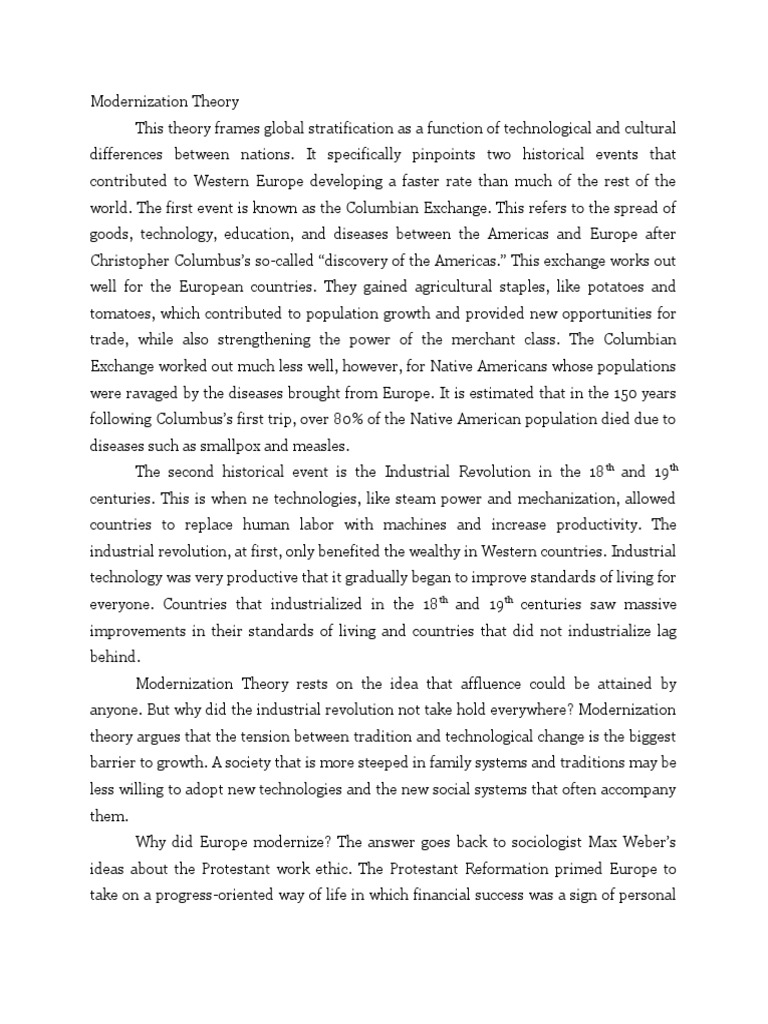The concept of modernization theory has often been likened to the gradual unfoldment of a flower, revealing new petals of understanding, growth, and adaptation to the ever-evolving global landscape. In its many manifestations, modernization theory elucidates the intricate interplay between economic development, societal change, and cultural exchange. This theory posits that societies progress through a series of stages that lead to a more advanced state of development, drawing richly from cultural exchanges that enrich the tapestry of human experience.
At its core, modernization theory suggests that the transition from traditional to modern societies involves not just an economic transformation but also a profound cultural metamorphosis. Imagine a river meandering through the landscape. As it flows, it carves new paths, nourishes the surrounding ecosystem, and, ultimately, transforms the very land it traverses. Similarly, cultural exchange acts as the water, shaping societies, fostering innovation, and enabling interconnectedness on a global scale.
Historical context underscores the emergence of modernization theory during the mid-20th century, an era characterized by rapid technological advancements and decolonization. Scholars sought to comprehend how developing nations could achieve prosperity akin to their industrialized counterparts. They theorized that a significant influx of cultural influences, facilitated by globalization, would set a stage for modernization through mutual engagement and exchange between cultures.
One of the most tantalizing facets of modernization theory is its capacity to elucidate the dynamics of cultural exchange through a kaleidoscopic lens. Consider cultural exchange as the lens through which we view globalization; it refracts traditions, beliefs, and values, illustrating a vibrant mosaic that is constantly shifting. In this ongoing process, traditional cultures adapt and incorporate elements from others, resulting in a hybridization that enhances both local and global identities.
However, this transformative process is not devoid of challenges. The initial enthusiasm surrounding cultural exchange can sometimes lead to cultural assimilation, threatening the integrity of indigenous identities. This phenomenon occurs when dominant cultures overshadow minority ones, akin to a towering canopy that blocks sunlight from reaching the flourishing forest floor. Thus, in the journey toward modernization, it becomes imperative to strike a delicate balance—preserving local cultures while embracing global influences. This endeavor requires vigilance and a conscious effort to foster inclusion and respect for diversity.
The economic dimension of modernization theory cannot be ignored. Economic development often acts as the catalyst for cultural exchange, fostering networks that facilitate international collaboration. As nations grow economically, they become more receptive to ideas, art, and practices from abroad. Trade agreements operate as bridges, connecting diverse peoples and facilitating the ebb and flow of cultural capital. This economic flowering often entails not only the spread of goods but also the dissemination of ideas, ways of life, and artistic expressions that shape societal norms.
Emphasizing the role of technology in this equation offers another layer of complexity. The advance of communication technologies serves as a powerful engine driving cultural exchanges. The Internet, for instance, has revolutionized the way information is shared across the globe, acting as a conduit for both knowledge and culture. Social media platforms can suddenly amplify local voices, allowing them to share their narratives with an international audience. In some cases, such platforms have given rise to movements that challenge traditional norms and promote social justice, leading to profound societal changes.
The visual arts, music, and literature stand as powerful testament to the richness of cultural exchange within the framework of modernization. Artists borrow from various cultural idioms, contributing to a dynamic dialogue that transcends geographical boundaries. The collaborative nature of art, interlaced with diverse influences, pushes the envelope of creativity and catalyzes innovations that reflect a more inclusive vision of humanity. Each piece created not only portrays an artist’s perspective but also embodies the interconnectedness of cultures influenced by globalization.
Nevertheless, it is critical to acknowledge the ethical implications inherent in cultural exchange. Cultural appropriation—where elements of one culture are adopted by another, often without permission—has generated considerable discourse regarding the power dynamics involved. This unwanted consequence, reminiscent of a vine choking the life out of a tree, underscores the necessity for awareness and sensitivity in engaging with diverse traditions. Engaging thoughtfully with other cultures requires empathy, respect, and recognition of historical contexts, ensuring that exchange remains equitable rather than exploitative.
Ultimately, the interdependence of cultural exchange and modernization invites a reflection on the nature of progress itself. Are we moving towards a homogenized global culture, or are we paving the way for a diverse mosaic of identities? The answer lies in our collective commitment to preserving the unique aspects of each culture while also embracing the innovations that emerge from cross-cultural interactions. Much like a symphony composed of diverse instruments harmonizing together, cultural exchange can yield profound beauty when approached with intention and respect.
In conclusion, the intricate relationship between cultural exchange and modernization theory unveils a complex tapestry of human experience that merits thoughtful exploration. As societies navigate the currents of globalization, they must remain attuned to the delicate balance between embracing change and honoring tradition. Such vigilance guarantees a vibrant cultural landscape, enriched by the diversity of human expression while propelling forward into a future that values inclusion and creativity for generations to come.
